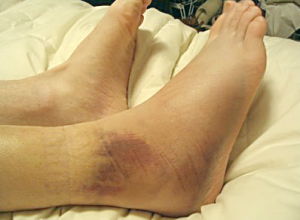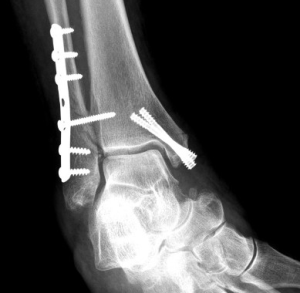Broken ankles are one of the most common types of joint and bone injuries. Most people tend to visit a doctor due to occurrence of symptoms such as pain, difficulties in walking or due to concern of a bone being broken.
Broken ankle can often because a cause of worry, if there is a broken bone. On most occasions, it is difficult to verify whether a broken ankle consists of dislocation, sprain, injury of the tendons or an actual broken bone or fracture, unless X-rays of affected ankle are taken.
Broken Ankle Symptoms
The signs and symptoms of a broken ankle are usually very noticeable. They are as follows:
- The most common symptom of broken ankle in pain in patients
- The patient may not experience the pain in the exact location of the fracture
- The pain in the ankle may affect the patient’s ability to walk comfortably
- The pain may also be caused due to related fractures of the foot, particularly located on the side of the small toe, or knee fractures which cause broken ankle-like pain
- Swelling of the areas around the ankle is another frequent symptom
- Swelling or inflammation indicates accumulation of fluid, often blood, within the affected joint, or damage of the soft tissue with possible collection of blood surrounding the affected joint.
- The presence of blood within the joint is known as hemarthrosis
- Extreme cases of broken ankles may result in noticeable distortions of the bones surrounding the affected ankle
- The bone may jut out
- The skin occurring over a broken ankle may get stretched or elongated
- A bruise can be visible around the affected joint after the passage of some time. Such a bruise may be traced going towards the toes or to the sole of the foot.
- If individuals with broken ankle also suffer from injuries of the blood vessels or nerves that carry blood to the foot, then additional symptoms of severe pain along with numbness, paleness of the skin on the foot and incapability to move the toes or the foot may also occur.
Causes of broken ankle
- Extension or stressing of the ankle joint beyond its capability to bear the load or stress, can result in a broken ankle.
- Tearing away of just the ligaments causes ankle damage referred to as a sprained ankle. When the ankle injury involves a broken bone, then the resultant damage is called an ankle fracture
It is also possible for a broken ankle or fractured ankle to occur along with concurrent tearing of the ligaments. This can occur in the following ways:
- Constant twisting of the ankle from one side to the other
- Constant rolling of the ankle from the inside to the outside
- Application of extreme force directly on the ankle joint, which can occur when jumping from a great height
- Severe extension or flexing of the ankle joint
Broken ankle treatment and surgery
- A broken ankle is usually treated by placing a splint on the injured ankle for some days to up to two weeks, till the inflammation surrounding the joint is reduced.
- The stability of the broken ankle as well as the type of fracture will aid in the determination of the kind of split to be used and whether surgery is necessary.
- If the bones cannot be realigned properly in the emergency department, then the patient may require an operation.
- In case proper realignment of the bones is not possible, then an operation may be needed
- Surgery will also be required if the broken ankle experiences exposure of the bone through the skin. Such an ankle fracture which features jutting out of the bone through the skin is known as a compound fracture, and is more serious as compared to a simple fracture.
- A few types of broken ankles may not need to be casted, and are treated as an ankle sprain. In this case, the ankle injuries are very tiny and can be treated with correct management. It is however important to note that patients with broken ankles should not place any weight on them until a cast is placed or the affected joint in pain free.
- After the swelling is reduced, the doctor may evaluate the kind of cast that needs to be placed and will recommend the use of crutches to aid in walking.
- Pain medications may be prescribed to alleviate the accompanying pain
Broken ankle recovery information
- Immobilization and non weight bearing activities can assist the healing process of a majority of simple cases of broken ankles. Complex ankle fractures may yield good to fair prognosis as per the rehabilitation effects on functionality, the severity of the broken ankle and the onset of arthritis
- Depending on the severity levels, most cases of broken ankles have a recovery time period of 4 to 8 weeks for completely healing of the broken bone and then many months for regaining the full use and degree of motion of the affected joint
- Surgical repair that involves implantation of metal plates or rods or screws may take a longer time to heal. Such implants may be left in place or be removed later
Broken Ankle Pictures




I have viewed that sensible real estate agents just about everywhere are starting to warm up to FSBO Advertising and marketing. They are acknowledging that it’s in addition to placing a sign post in the front area. It’s really pertaining to building relationships with these dealers who one of these days will become purchasers. So, after you give your time and efforts to aiding these vendors go it alone – the “Law of Reciprocity” kicks in. Great blog post.
Wow! Thank you! I continuously wanted to write on my site something like that. Can I take a part of your post to my site?
That is some inspirational stuff. Never knew that opinions could be this varied. Very creative, one of the nicer sites I have seen today. Keep up the great work.
Awesome issues here. I’m very glad to see your post.Thank you so much and I am looking ahead to contact you.Will you please drop me a e-mail?